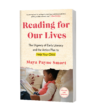February is Black History Month—a dedicated time to acknowledge, celebrate, and honor the contributions of African Americans in the United States. During this month, we reflect on over 400 years of heritage and history, paying special attention to the unique struggles, successes, voices, and experiences of black Americans. Check out this curated list of books for young adult readers to help them learn and appreciate black history, not just in the month of February, but all year round.
These 11 books only begin to scratch the surface of the stories and contributions of African Americans. What are your favorite black history books for teens? Let us know!
By Maya Smart
What does Santa Claus really look like? Nancy Redd’s new children’s book, The Real Santa, features one boy’s quest to find out. In today’s video, I chat with Nancy about this beautiful Christmas tale, the importance of representation in kids’ stories, and the behind-the-scenes process of creating a picture book.
Watch the video of our conversation, or scroll down for the transcript.
Thanks so much for joining us this afternoon. I’m so excited to hear about your latest book, but before we dive into this wonderful, beautiful, soon-to-be classic picture book for the holidays, I wanted to take you back to some of your childhood holidays in Virginia. What were some of the things that your mom did to bring the holidays to life in your home? Some of the traditions?
Oh, I love that. That’s such a great question. First and foremost, I love you, Maya and I love Christmas. Our Christmas began the day after Thanksgiving. We put the tree up and there would always be a lot of cooking. It was a very big deal putting the ornaments on because a lot of our ornaments are decades old and they’re a collection of beautiful, emotional products that we’ve just kept.
A lot of them were very special black Santa ornaments or black angel ornaments that they had found on some faraway trip. Because we’re from Southern Virginia, near North Carolina, a small town called Martinsville, and there were no stores for the longest time that carried a diverse array of possibilities. So whenever my mom or my dad or family member would travel to the big city or up north, they’d always come back with these incredible, diverse things.
And a lot of our Christmas decorations actually came from friends and family who would send us things from Philadelphia or New York or other cities. So it’s just a huge thing in my household. It’s my favorite holiday and Santa is one of my favorite holiday characters.
So I see a couple of young men in the background. One is your son, and then there is also another beautiful black boy asleep on his pillow. So tell us a bit about that character and also the boy who inspired him.
Yes. So The Real Santa is my children’s book and it is a wonderful story of a little boy, based not only on my son, but so many boys like him, and girls, and myself and my brother, who wondered what the real Santa looked like. And the answer really has never had a satisfactory ending for people of color. I wanted to create a joyous, inclusive, heartwarming tale that anyone can enjoy and have the spirit of Christmas fill them inside with wonder and imagination.
And I feel really lucky to have gotten the chance to share this little boy’s story based off of my own son, who still to this day stays up every night, as long as he can, to catch the real Santa in action. And he’s never successful, but like our protagonist, he ends up getting an answer that’s satisfactory and it maybe comes from his dreams, it maybe comes from reality, and that’s for the child to decide when they read it.
It’s such a lovely concept. And I can’t wait for all the families at home to get a chance to flip through and see that. I see also, in your backdrop there, the cover of your previous book, Bedtime Bonnet. Tell us what was different about your creative process and coming up with your second picture book, now that you’ve got one under your belt. Was it a little bit easier to dive into this book or did it present any challenges, all its own?
Every book presents challenges, because the books that I write come from a deep yearning in my soul. I’m fortunate to be able to pull them out, but it’s always a journey, because it’s a discovery for me. So, when I first started writing Bedtime Bonnet, it was because I was frustrated that my daughter didn’t want to wear her bonnet, because she never saw anybody wear her bonnet because she was not yet at the age of sleepovers, but her hair was getting messy because she didn’t want her bonnet.
But the cartoons on TV, African-American cartoons, never wore their bonnets to sleep. So she thought the bonnets were only for old people like me and grandma. So that was, it was hard. I’m always reminded by myself and the people I show my writing to, and especially, I’m very fortunate to have an amazing editor in Sarah Sergeant at Random House, [that] this isn’t about me. This is about the kids.
So, figuring out how to get messages across without the angst, but with the self-love and expression, for me, is always a challenge, because when I first started writing The Real Santa, the protagonist, the little boy was more frustrated. He was like, I see all these Santas, but I don’t know! I’m upset! I don’t know which one’s the real Santa!”
And my editor was like, “Look, I know this is emotional for you, but you got to dial this back. You have to figure it out from the perspective of the child.” Because the child is not upset. The child knows what Santa looks like. He’s just looking for confirmation. He’s not looking for an argument, right? So we tweaked and finessed until we came up with a story that, like Bedtime Bonnet, affirms and assuages any fears without causing conflict.
And in this book, in addition to the boy and all of the Santas, he’s also surrounded by this wonderful extended family. Can you talk about his sister, mom, and dad, and grandparents, and why it was important to show the intergenerational elements of that family in the book, as well?
I feel like it’s one of the best parts of family that needs to be incorporated more. I grew up—both of my grandfathers passed before I was born, unfortunately, but my grandmothers were extraordinarily pivotal in my life for different reasons.
My maternal grandmother, who I’m named after, Nancy, I spent most of my life with. I mean, we would literally come home from school and my mom would get in the car, we’d go to grandma’s house. And I was just hanging out there. I mean, it was just, like, literally my life. My grandmother’s as important as my mother, right? And I wanted to, I want to always express that in the work I do, how important intergenerational households are for me.
I really, in Bedtime Bonnet, I think it was really important for them to all be living together because I don’t see a lot of intergenerational households and I, while we were all in different houses, we may as well been living together. I mean, sometimes I’d spend the night over there and sometimes I wouldn’t. And I want people to see our joy, our private lives and how beautiful and interconnected we are and how loving everyone is.
You mentioned some of the notes that you made for the illustrator to help her come up with visuals that amplified what you wrote in the text and also helped to add another layer of storytelling to the book. Tell us about that collaboration between the writer and the artist.
It’s really fun. And I feel very fortunate to be able to do so. I can’t draw worth a lick. You know, my daughter loves art, like your daughter, maybe they’ll illustrate our books one day. But I’m very lucky to have collaborated with two incredible illustrators for both of my books.
And what people don’t realize is they’re not just working in a vacuum. The author offers art notes and they can be as simple as “family in living room.” I choose to go more detailed with what I want each character to do, because there are a lot of subliminal messaging and Easter eggs that I like to put in my books and also representation. Small things, such as in Bedtime Bonnet, on the cover of the book, I wanted her to have an earring in her ear. I wanted her to have a beautiful lush robe, right? Instead of reality, like a tattered nightgown, which is what I’m actually living in, but that’s neither here nor there. We’re aspirational with these books.
And so, with The Real Santa, we had a lot of fun coming up with imagery that expressed joy, love, trust, safety, security, and with—keeping a little bit of magic. And so some art notes might be one or two sentences, like “family outside.” There is a snowman Santa. There is a mailbox Santa, there is a black Santa decal on the car. There’s a black Santa on the window. There are black Santas everywhere, because that’s what I grew up with, right?
And then the artist somehow brings it to life. I have no idea how they do it. Charnelle did such an amazing job in this book, somehow living in my brain. And it’s partially because she, too, lives this truth, right? She knows exactly what I’m trying to do. And that’s the power of our own voices, and the power of when you have an illustrator and author team who truly get the subject from a yearning inside of wishing we had this when we were growing up. That’s how you get to this, which is really outstanding, her work is.
Recently, in your career, you focused on writing for children and picture books has been your chosen format, but throughout your writing career, some of the same themes of representation and safety, security, some of the other things you’ve mentioned, have come up in other ways in other work that you’ve done. Can you talk about the trajectory of your writing career and what’s up next for you?
Well, I have to laugh, because my first book, as you know, when I was 26, was Body Drama, which was the first ever photographic guide to puberty. And it was because I was a young lady and I felt uncomfortable about aspects of my body. And I didn’t want anybody to feel uncomfortable about aspects of their body. I was very close to teenagers, at 26, so I wrote for teenagers.
And then, as I got older, I wrote more books geared towards women. Like, when I became a mother, I wrote a nonfiction book, called Pregnancy, OMG, which is a photographic pregnancy book, right? It’s a mom-to-mom book.
And then I became knee-deep into motherhood and was looking at the books that were out there and saw gaps and holes that I wanted to fill with my version, my vision, for what my children see in themselves and the written word. And it’s so much fun to be able to do this, and I feel very fortunate.
So, for the typical child who picks up this book and reads it, is not—to your earlier point—going to have all of this background and context and complicated ideas about race and representation in their mind as they’re reading. After you got through the process of working through all of those issues, coming up with your title, telling the story the way you wanted to tell it, setting it aside for awhile, when it comes in the mail and you hold that hard copy in your hands for the first time, how does that feel? Does it feel resolved and now you’re ready for a new challenge? Or is this a challenge and is representation something you’ll continue to revisit?
This book arrived yesterday. One of the reasons I have all of these pillows and stuff is because I didn’t know if the books would arrive in time for our publicity boosts. So I had to have something [so] people could see the cover of the book, but the book arrived. And as soon as it arrived, my son just totally went ballistic, because he was like, “Yes, my book!” You can see, he also loves Christmas. (That’s him right there.) He loves Christmas so much. And he loves that his story has been placed in the historical experience of all children’s wonder, many children’s wonder, of who this jolly icon actually is, what he actually looks like.
So for me, it is a closure of sorts. I did, I’ve done everything I can, just like with Bedtime Bonnet. When I first came up with that idea for a book, it was considered preposterous, like who wants to read a book about a bonnet? Well, you know who wants to read a book about a bonnet? A lot of children who didn’t understand what a bonnet was and why their mommas and daddies, you’re trying to make them wear one.
And my favorite is looking at the reviews of the book and the ones that say, “My daughter didn’t want to wear her bonnet until we got into his book. And now she asks for it every night, and we play games with grandpa hiding the bonnet.” You know?
And that’s just so heartwarming, because it takes something that a lot of us, myself included, grew up with a little bit of shame about, right? Like we weren’t out here like proudly wearing our bonnets, or talking about our bonnets as a critical, key facet of our beauty routines. But now that shame may have been eliminated or at least minimized for the next generation.
And so a similar feeling is, with The Real Santa, so that for this next generation of children, they’re not growing up othered. They have options, they have representation. They have something, a north star to look towards for the beliefs that are held near and dear in their hearts and in their family. And they don’t feel left out of the large mainstream conversation.
Well, thank you so much for the work that you’ve done in both of these last two picture books. As a mom, I’m so happy to have them on our bookshelves at home. Well, soon, I don’t have this one in hard copy yet, but I’m excited to add it.
I just got it. Yours is on its way!
To add it to my shelf soon so Zora can appreciate it and share it with her friends. Again, thank you, Nancy. It’s been wonderful to chat.
Thank you. I’m excited to add your book on my bookshelf.
Thank you.
If you’re looking for a cute and inexpensive stocking stuffer, you can make your own Christmas bookmarks for kids using our free printable template. These color-your-own bookmarks make a sweet little gift to encourage children to read and a fun holiday activity to do with them on Christmas eve or the big day. They’d make a creative addition to a family Jolabokaflod celebration (an awesome Icelandic Christmas “book flood” tradition we’re trying this year). And they’re also a good option as a homemade gift for kids to make for their loved ones.
Helping your child make a personalized bookmark is a fun way to encourage them to pick up their favorite books and read them. And that’s one of the most important habits they can learn in life, since reading is a key to everything from academic success and career prospects to building emotional intelligence. Then, once they’ve got their bookmarks, make sure they have something enticing and inspiring to put them in, by providing some new reads, whether from the bookstore or the library. Our list of winter holiday books by black authors is a great place to start.
Our free bookmark printable consists of three Christmas-themed bookmark designs that kids can color in. This helps younger children develop their fine-motor skills and their creativity (and serves as a simple and easy-to-make favor for last-minute holiday preparations). Scroll down for the printable files and tips. You can also get ideas for more DIY Christmas gifts in our post about 6 easy crafts that support literacy and make great stocking stuffers. And don’t miss making our free printable Christmas alphabet book, our holiday lights craft spelling activity, and DIY Christmas ornaments that support reading (well, at least the recipe does…).
Materials:
- Printer
- Cardstock paper
- Coloring materials
- Scissors
- Self-laminating sheets/contact paper (optional)
Cost: $1-5
Just download the bookmarks and print them on a piece of cardstock paper. A sturdier paper like cardstock is ideal to make bookmarks more durable. You can also just print it on normal paper and then laminate your bookmarks after coloring them.
Next, cut out the template to make your bookmarks. Optional: If you have a corner puncher, you can also use that if you want to make your bookmarks with rounded corners.
Then color them in! If you’re laminating your DIY Christmas bookmarks in contact paper/self-laminating sheets, do that once they’re colored in. Alternatively, for a giftable activity, skip the coloring and put the plain bookmarks inside your child’s Christmas stocking or stick them on top of a gift to someone else. On Christmas eve or Christmas day, the recipient can color in their bookmarks.
Tip: You can also add colorful tassels to your bookmark by punching a hole at the top and tying a bunch of yarn through the hole.
Book Pairing: We love starting any activity with our children by pulling them close and sharing a good book together. That said, with bookmark crafts it can also make sense to save the reading for last, so you can put your new bookmark to use! With a picture book that you read straight through, you can use the bookmark as a tool to draw attention to print rather than to mark your page. Just put it under each line of text as you read, sliding it along the line as needed.
We recommend pairing this DIY bookmark activity with the book The Real Santa by Nancy Redd. Alternatively, browse our list of winter holiday picture books by black authors for some other awesome Christmas reads for kids, or snag your favorite holiday book and snuggle up for story time.
Want to make more bookmarks? If you love these Christmas-themed bookmarks, try our other easy make-your-own-bookmark tutorials: cute DIY cat bookmark, DIY fruit-slice corner bookmark, DIY chunky tassel bookmark, DIY elastic bookmark, DIY cut-out-shape bookmark. Or get access to all of our bookmark printables when you sign up for our free VIP (Very Intentional Parent) Vault of resources.
And remember, MayaSmart.com is your one-stop-shop for raising a reader, from evidence-based advice (like how to teach kids their ABCs) to fun activities that support key literacy learning and recommendations of great reads. Browse around the site for more tips and tutorials!
Like this post? Share it!
There’s something so unifying in cheering on Olympic athletes as they strive for excellence on the world stage. The summer and winter Games also offer an opportunity to teach kids important lessons about resilience, teamwork, discipline, winning, and losing. So go for the gold during read-aloud time with these picture books about the Winter Olympics!
Dive into the world of winter sports and join these storybook characters (real and fictional) as they glide along ice, soar through the air, speed down slopes, and set new records. From silly reads featuring skiing penguins to the true stories of barrier-breaking athletes, these books will inspire and entertain your own little athletes all year long.
For more Olympic adventures with this delightful snowman, add Snowman Paul and Kate’s Olympic Dream and Snowman Paul Returns to the Winter Olympics to your list, too.
Bonus reads about winter sports and adventure:
What’s your favorite book about the Winter Olympics? Don’t miss our roundup of Summer Olympics books for more inspiring Olympic reads!
Grief can have a lasting effect on anyone, regardless of age. Like all of us, young children feel devastated if they lose someone precious to their heart. With the confusion of not understanding what’s going on, they can be left without any idea of how to cope. Fortunately, there are many literary resources available for parents to help kids heal and manage their grief.
Picture books about grief and loss are a powerful way to help younger children understand the grieving process. Here are a few titles that may help them on their journey of coping with their feelings. These selections also encourage young readers to hang on to their dear memories of the departed to comfort them when they need it.
Have you found any of these stories helpful in explaining grief and loss to young children? Please share your experience in the comments or by messaging us.
Want your kids to be kind, compassionate, and open-hearted? Then you’ll be pleased to know emotional intelligence, including empathy, is learnable. As parents, there’s a lot we can do to model and teach it to our children—from showing them how we engage with others in daily life to imaginative role play games. Still, there’s no one-and-done way to teach empathy to kids. It’s a gradual process, and (as parents can testify) younger children don’t always find it easy to understand others’ perspectives, put words to feelings, or react compassionately. Which is where kids’ books that teach empathy come in.
Books, especially story books, are powerful tools for building empathy skills. To quote Neil Gaiman, “Fiction gives us empathy: it puts us inside the minds of other people, gives us the gifts of seeing the world through their eyes.” And for younger readers, picture books—through subtle interplay of words and illustrations, or even illustrations alone—can distill complex emotional ideas without feeling prescriptive or labored. Best of all? They often spark enlightening conversations around feelings.
Like the idea of including books for empathy as part of your child’s reading? From true stories to playful explorations in perspective and deeply moving tales, our list of empathy books for toddlers and preschoolers has got you covered.
Which children’s books about empathy sound good to you? Have a suggestion to include in our list? Let us know!
Winter is here and you know what that means. (Or may I say, you snow what that means?) It’s time to help your kids make some seasonal crafts and decorations! And because we’re all about raising readers at MayaSmart.com, we’re going to throw some literacy practice into the mix, too.
In this educational winter craft, we’ll make word family snowmen that teach kids reading skills and make cute decorations for your home. All you need for this easy activity is 15 minutes (or less if you sign up to get our free printable—details below!) and some basic materials.
Word families are groups of rhyming words that share the same ending (both the spelling and pronunciation). For example, the “-op” word family includes words like hop, top, pop, and so on. Word families are useful teaching tools that help children recognize patterns and build awareness of the sound structure of words. As they learn to connect certain letter combinations with particular ending sounds, kids can more easily read and spell new related words.
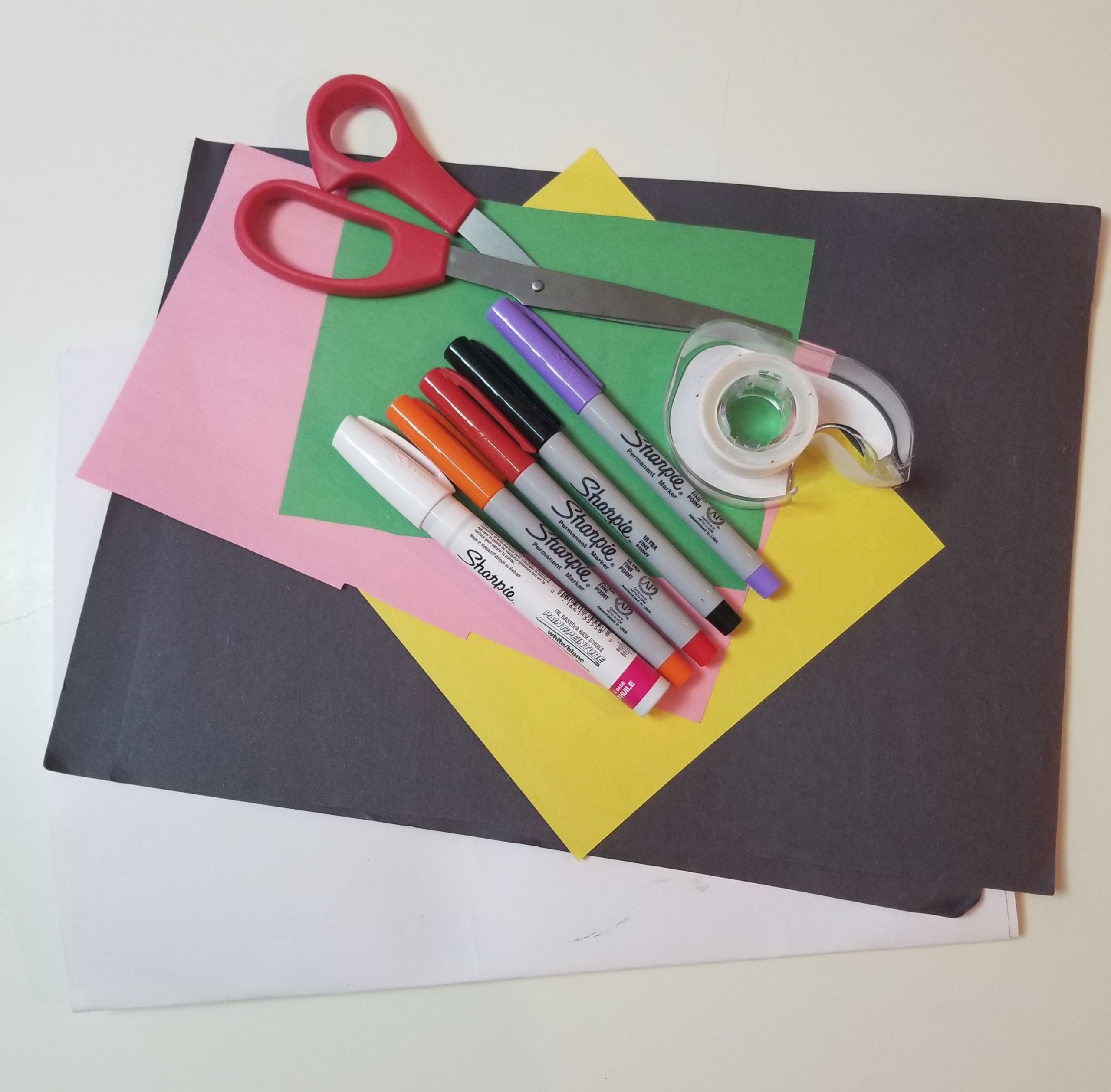
Materials:
- White or silver permanent marker
- Construction paper/cardstock: 1 sheet each of black, white, and 3 colors
- Scissors
- Tape or glue
- Markers
Cost: $0-5
Set the Scene: If you’re ready to really get in the snowman spirit, I highly recommend reading one of these terrific snow-themed books to go along with your educational winter craft. Snuggle up and read Snowmen at Night by Caralyn Buehner, The Snowy Day by Ezra Jack Keats, A Big Bed for Little Snow by Grace Lin, or Snowballs by Lois Ehlert. (Got other snowy favorites? Let us know in the comments below or on social media!)
Step 1: Cut out nine white circles, 3 to 4 inches in size. (You’ll need to fit paper “buttons” inside.) This will be enough for three word-family snowmen. I find that any more gets a little overwhelming for preschoolers.
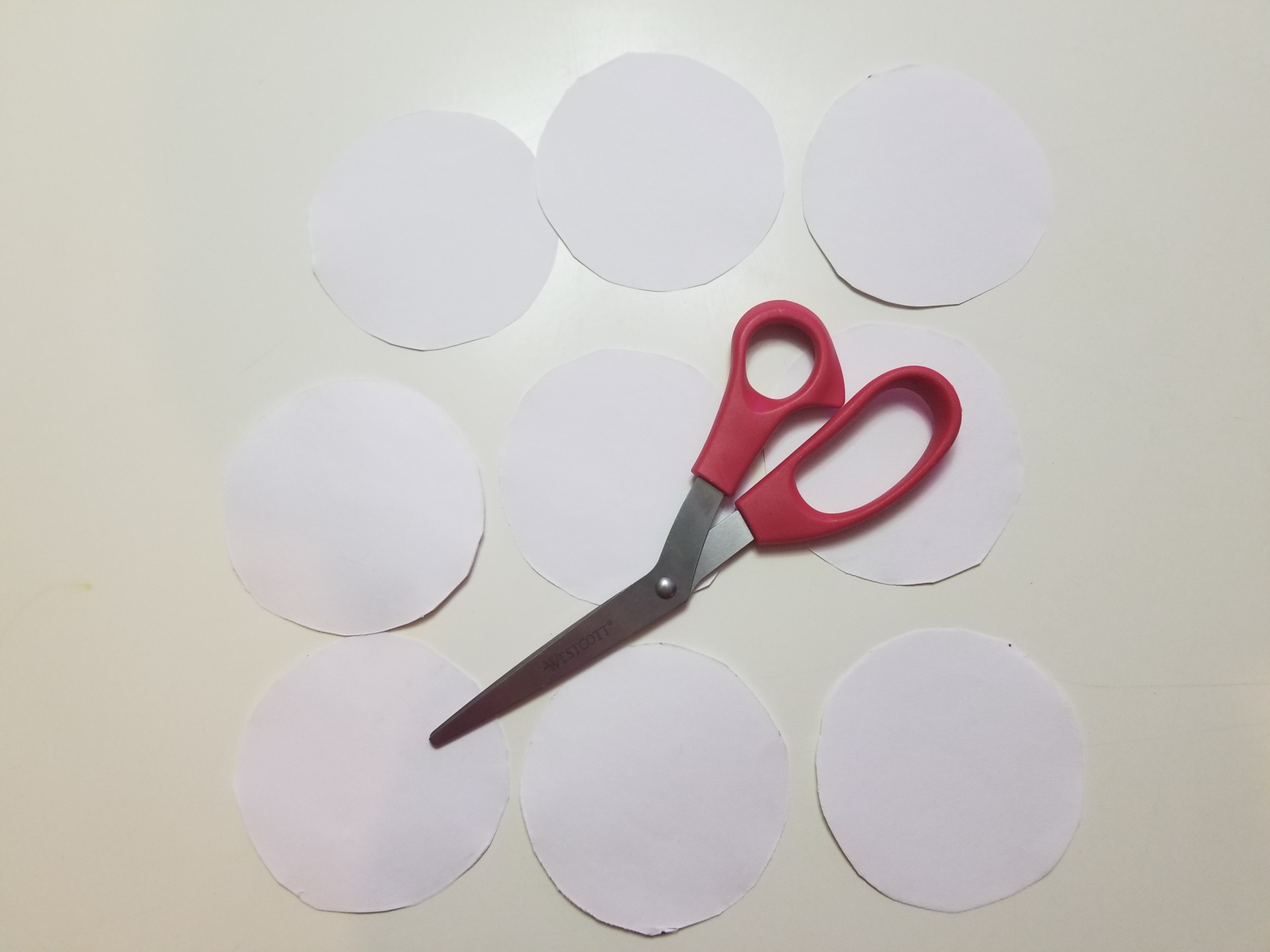
Step 2: Invite your child to help you draw faces on three of the circles.
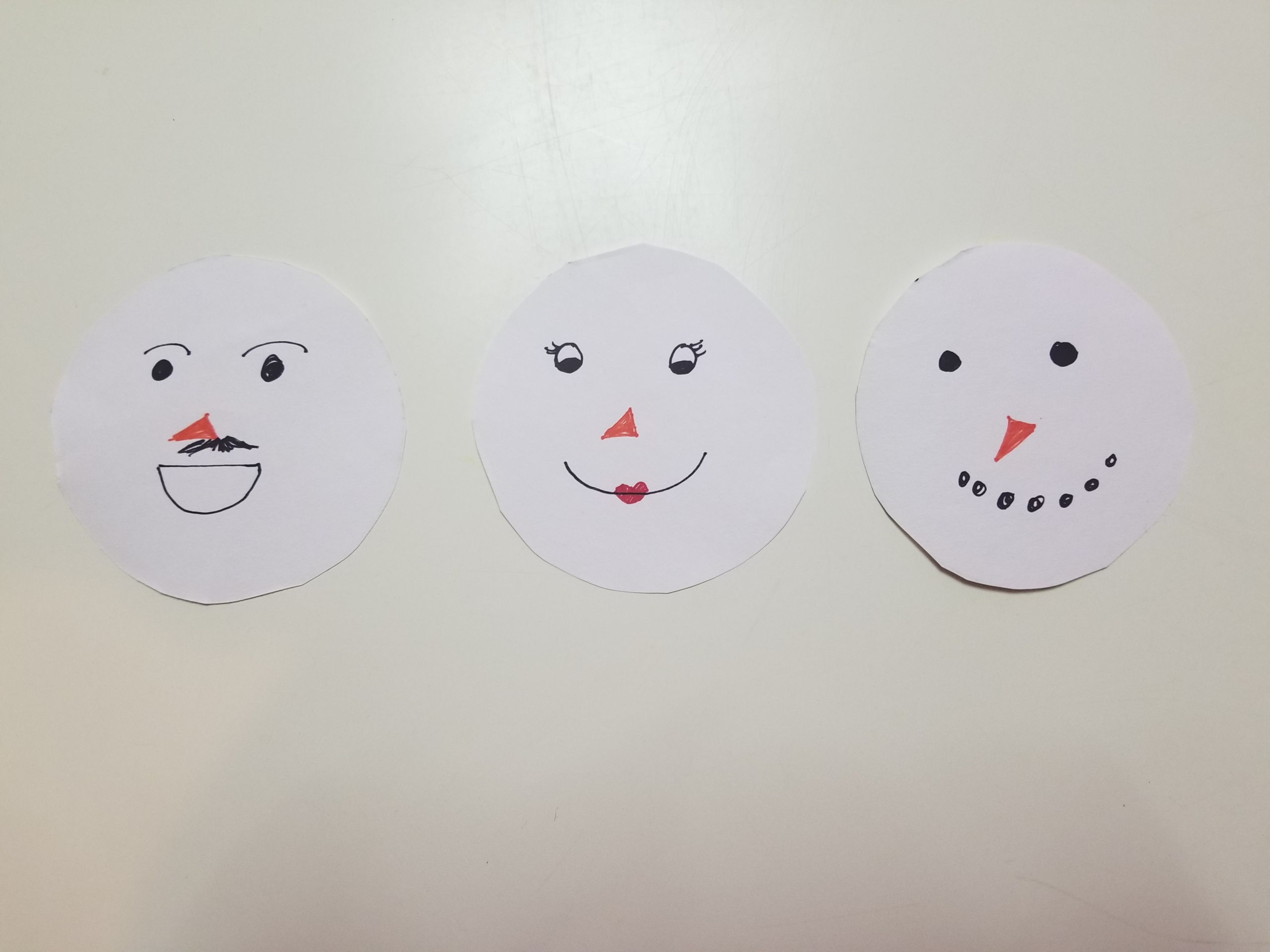
Step 3: Cut out three top hats from the black paper. Write a word-family ending on each hat using a white or silver sharpie. Some great options include “op,” “at,” “an,” or “in.”
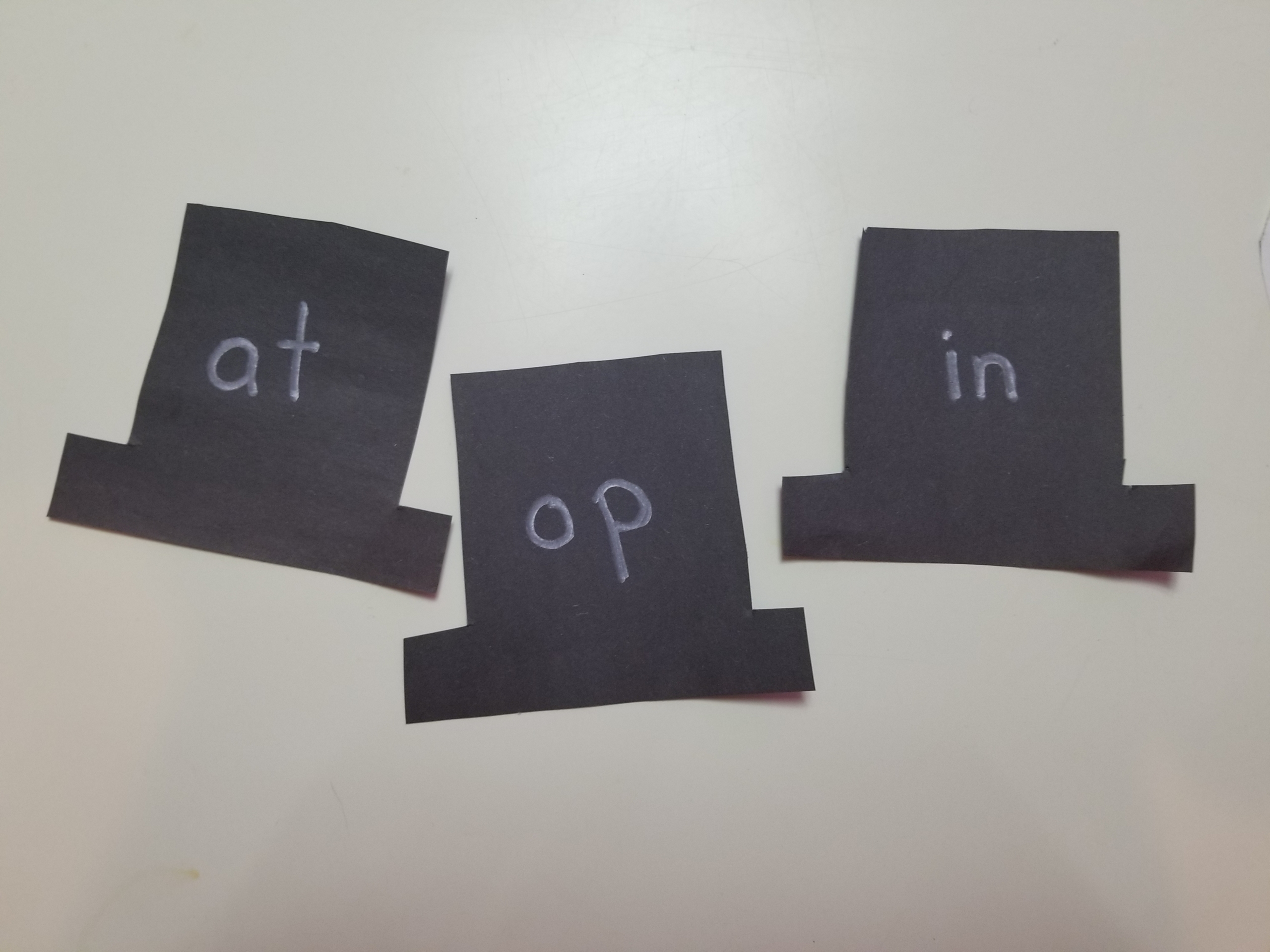
Step 4: Tape or glue the circles and hats together to make three snowmen.
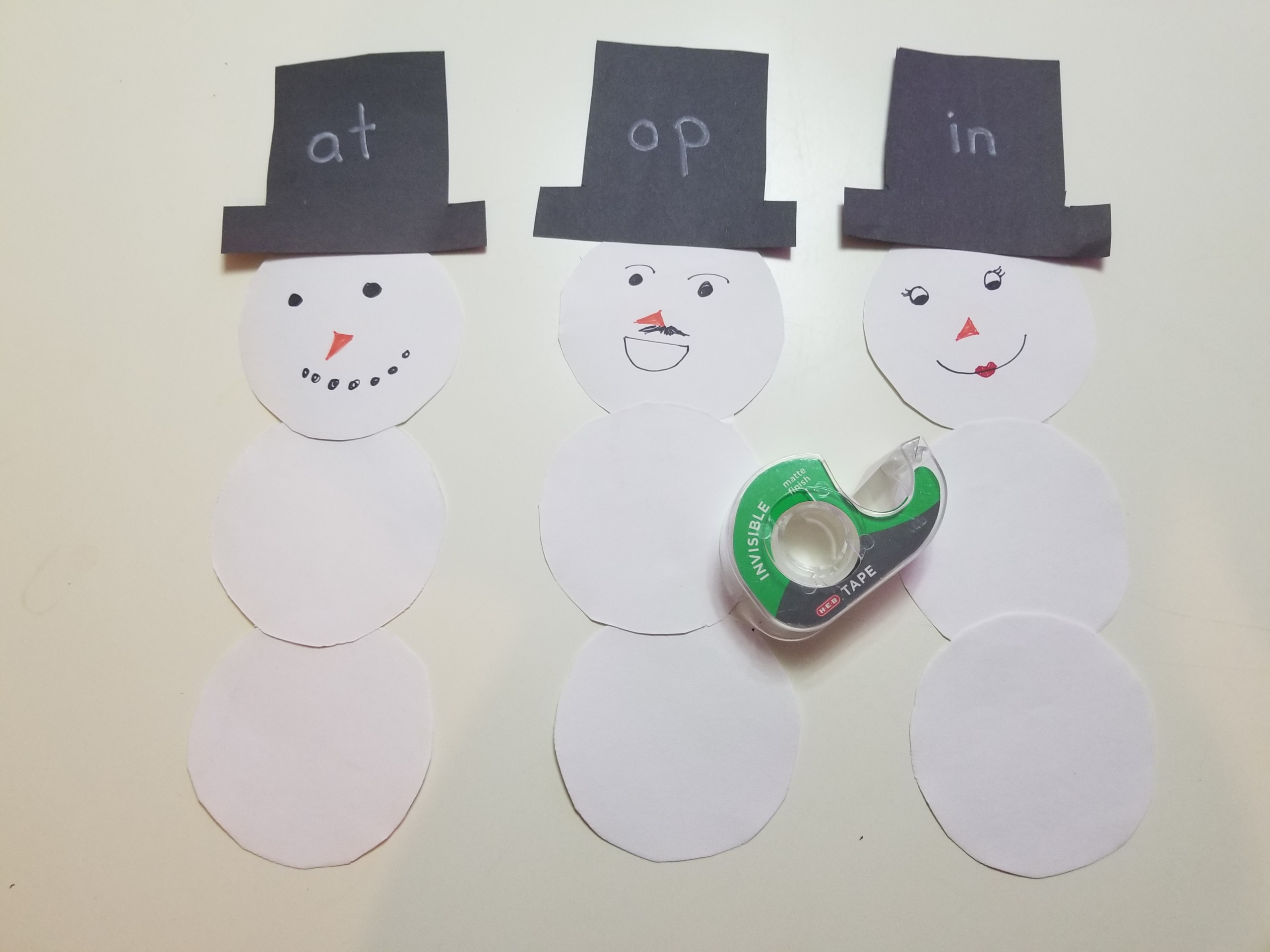
Step 5: Use the colorful paper to make buttons by cutting out circles that are about 1½ to 2 inches across. (They need to have room to write a word on, but still fit on the snowman’s body.) I recommend cutting out two to four buttons per snowman.
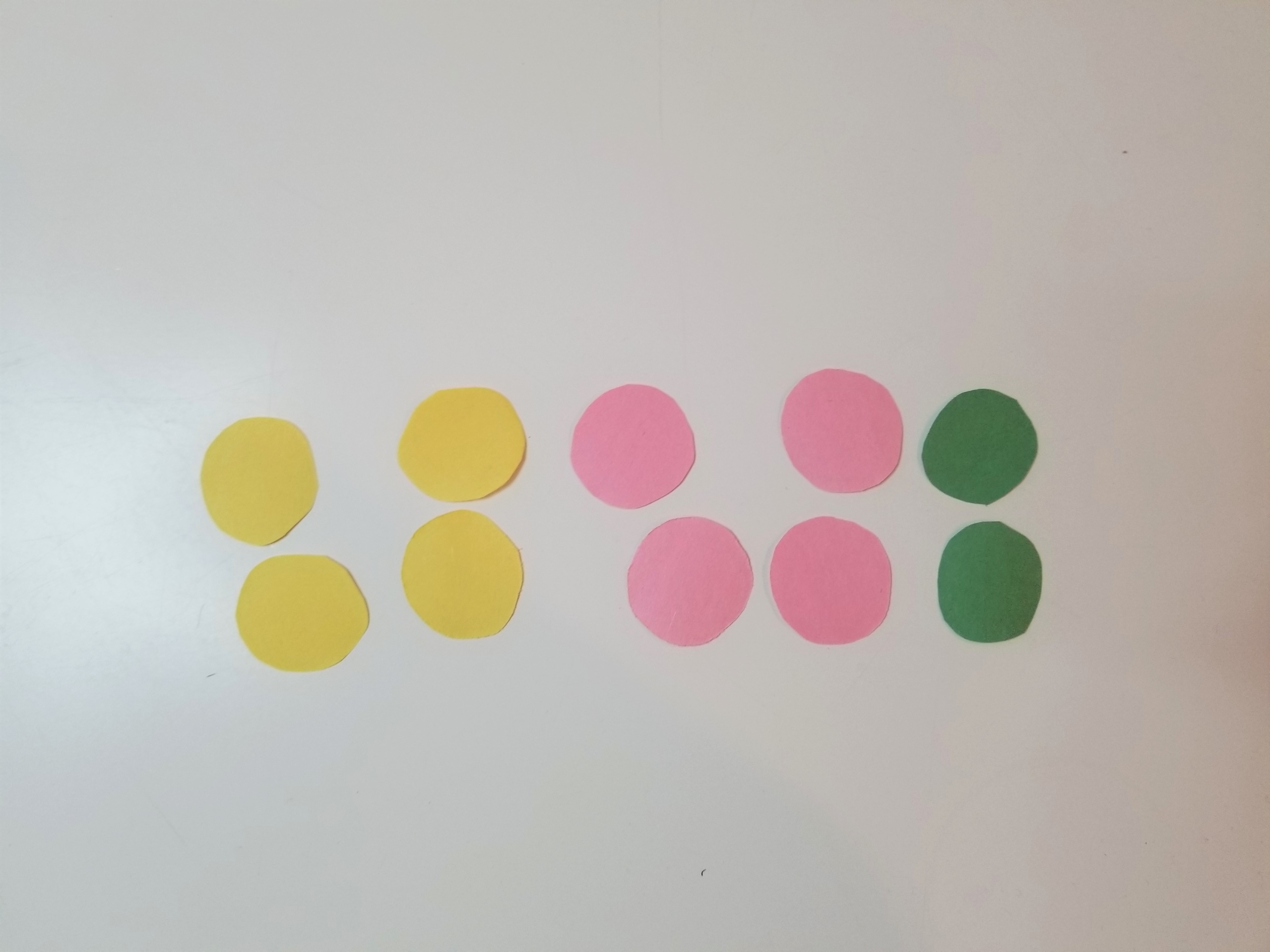
Step 6: On the buttons, write words that correspond with word families. For example, hop/pop/mop/top, cat/hat/mat/bat, tan/fan/ran/man, fin/win/bin. You can also let your child write the words with guidance from you.
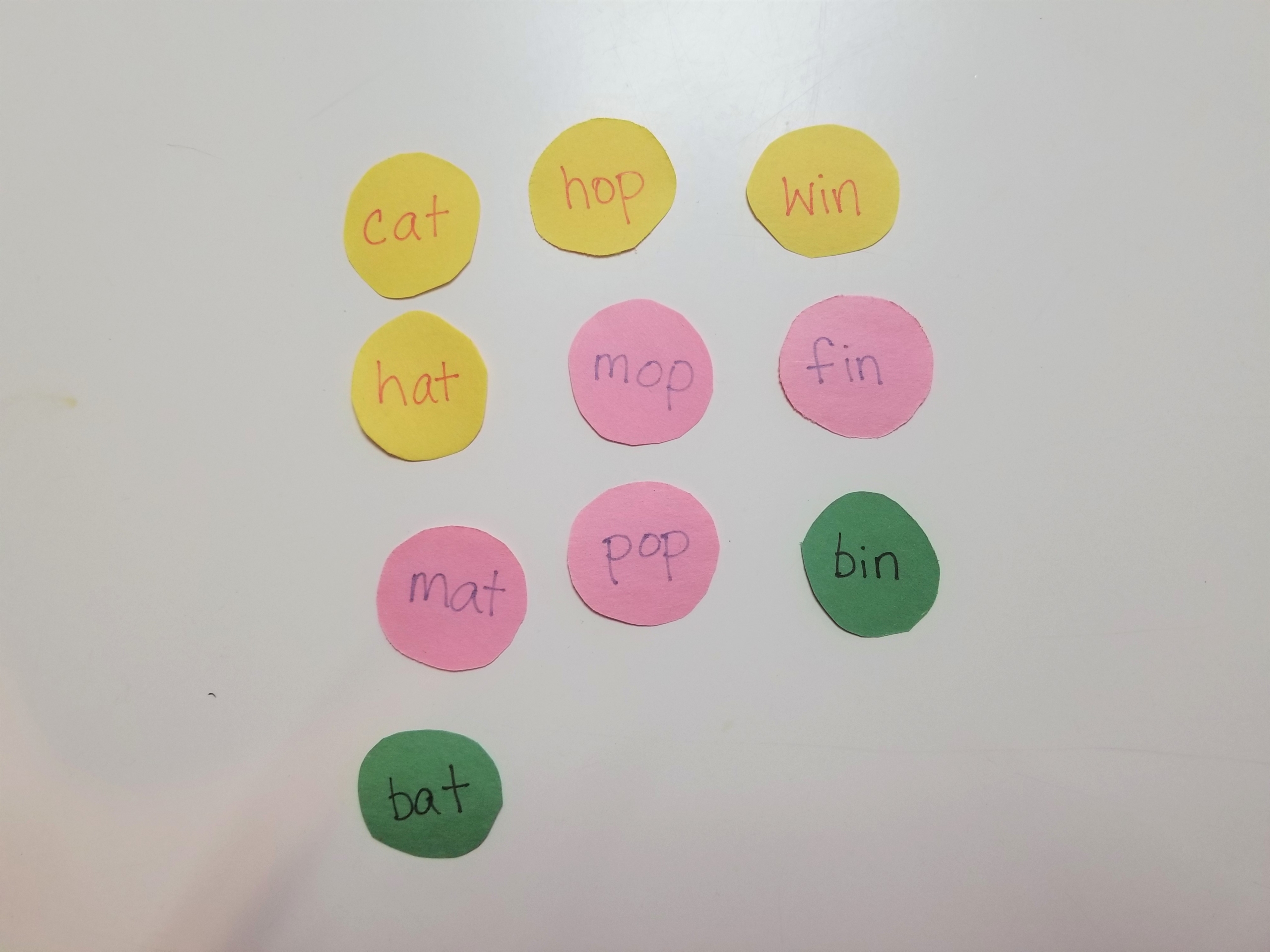
Step 7: Review the word-family sounds on each hat with your child. Then, help your child match the buttons to the correct snowman. If they can sound out the words themselves, great. If not, read the words to them and ask them to figure out which snowman they belong on. Repeat until all the snowmen have their buttons!
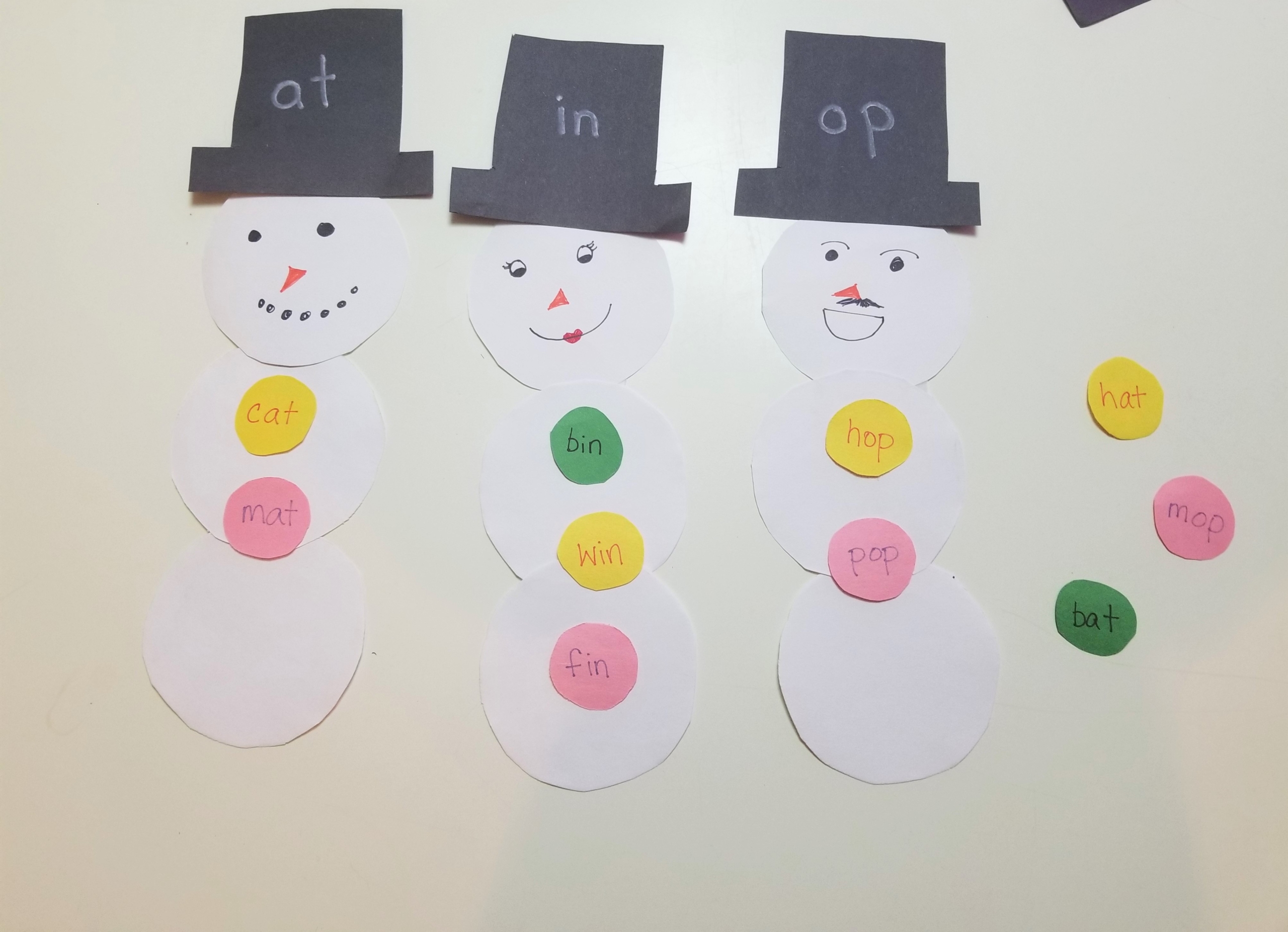
Feel free to glue the buttons on as they complete the snowmen to make some cute educational decor for your walls, or take the buttons off so they can play all over again any time they want.
And there you have it! With just a few minutes of crafting, you’ll give your child valuable reading practice—and have a great time doing it. If this educational winter craft doesn’t melt your heart, I don’t snow what will.
Did you make this word-family snowman craft with your child? Send us pictures!
Some of my favorite childhood memories were spent close to nature. Whether it was a visit to the local picnic area, being on a family camping trip, or reading a book at the base of a tree, being outdoors surrounded by growing plants was restorative and stimulating. When I became a parent myself, I saw the same benefits for my children as they grew—they were more engaged and enthusiastic when learning took place in an outdoor setting.
Spending time outdoors in natural green spaces provides major benefits for raising readers, and being in nature may even make kids smarter. Researchers (and parents) have observed a plethora of mental, physical, and emotional benefits to getting children outside and active. According to the Journal of Pediatric Nursing, exposure to green spaces promotes memory, self-discipline, and attention. It also reduces stress, encourages positive social growth, and improves behavior.
Being in Nature Can Help Kids Learn
A study in Barcelona followed just over 2,500 primary-school children for a year to better understand the effects of green space on their cognitive development. The researchers found that exposure to such spaces correlated with an improvement in the kids’ working memory and a significant boost in attentiveness. A related study even suggested that regular exposure to such spaces during childhood was associated with increased brain size.
Another study, this time by a group of medical professionals in Rome, showed improvement in kids’ attention levels when they spent time in green spaces, and a positive association with their verbal IQ as well.
And researchers following preschoolers in Norway found that “high exposure to outdoor environments might be a cheap, accessible and environmentally friendly way of supporting and enhancing children’s self-regulatory capacities and cognitive development.” Those researchers even suggested that outdoor exposure could be used to “treat” children with attention disorders: “For some children, high doses of nature may be an effective alternative to medication,” they speculated.
Green Spaces May Reduce Stress & Improve Mental Health
What’s more, scientists in the UK were able to link reduced stress levels to green spaces by measuring levels of stress hormones in participants’ saliva. Researchers saw an increase in the hormone cortisol when subjects were deprived of natural environments.
Similarly, another study found that children between two and five years old who lived in areas with more green spaces around had fewer symptoms of anxiety and depression.
So, if you find teaching reading to your child a stressful endeavor, why not take the literacy learning outside? Both of you may enjoy a breath of fresh air.
How to Find Natural Areas in Urban Environments
While I was fortunate to grow up in a time and place that offered abundant opportunities to explore nature, in many areas those opportunities are shrinking. Many urban areas were built without regard for nature, and it may be difficult to find a patch of green in some areas. This is particularly true of disadvantaged urban areas.
Fortunately, cities are starting to see the value in prioritizing natural areas. Small areas of green are popping up all over the place. Communal gardens and green spaces have been created by reclaiming derelict or vacant properties, like Platt Farm Open Space in Denver, once a dumping ground for industrial waste.
In addition, many public libraries, such as those in Los Angeles, Denver, Orlando, and New York, offer a limited number of free cultural tickets to library cardholders. Most of these programs have a few nature-centered destinations, such as botanical gardens and zoos, among the museum and theater options. In most cases, parents can take advantage of these free programs via their library’s website and book their free passes online.
Cities frequently have nature and discovery centers to visit, as well. Nature centers often offer educational walks, maintained trails, habitat restoration, and sometimes even wildlife rehabilitation services. Those who want to get more involved may be able to volunteer, helping with tasks such as clearing invasive weeds, planting trees, and cleaning up trash.
How to Help Your Child Learn In Nature
The research suggests that letting your child play and explore in outdoor spaces is beneficial for their cognitive development all on its own. Adding in fun activities that are specifically designed to fuel their development of reading skills will make the time outdoors even more constructive.
You can name the plants and animals you encounter, weaving in spelling lessons when you encounter a B-U-G on a leaf or a C-A-T in a tree. Vigorous activities like a rousing scavenger hunt or a game of alphabet hopscotch will help your active preschoolers get their excess energy out so they’ll behave better at home. After allowing them to expend their excess energy outdoors, you can sit down with your kids and read a book about the outdoors.
Check out these curated lists of recommended picture books about the outdoors and picture books about gardening for a great start!
Like this post? Share it!
When the holidays and school vacations roll around, they bring family time for many of us. Not just time with the members of your household—visits with extended family. Big gatherings and family meals. Going to stay with relatives, or hosting them at our homes. Grandparents visiting or coming to stay. Cousins, aunts, uncles. So. Much. Family.
Gathering and reconnecting with loved ones near and far, within and across generations, is a source of great joy. It can also represent an upheaval: sharing space, dealing with differences, and getting along with others, to name a few. Not to mention handling a bunch of extra noise and chaos on the one hand and different rules or expectations on the other.
As with just about any subject under the sun, we believe that sharing a book is among the absolute best ways to broach this topic with your kids. A great story can simultaneously validate children’s feelings while gently helping them see how to resolve, accept, or evolve them. The truly great ones will even help us parents, too.
Below are a couple of moving picture books that are well suited for prepping young children (and, really, the whole family) for gatherings and visits with extended family.
More Books About Relatives
Has your child ever refused to sit on the lap of a grandfather they hadn’t seen in a while, wiped off a kiss from Grandma, or otherwise been embarrassingly less than effusive around relatives? Have grandparents or other family members ever looked askance at the noise or, shall we say, energy levels of your little ones?
If you’re planning some time with relatives that your children don’t know well, or just haven’t seen in some time, a good picture book can help, such as Oliver, Amanda, and Grandmother Pig by Jean Van Leeuwen.
Picture books are a fantastic way to broach topics of importance with your little ones, and one topic that could use more attention is the relationship between senior citizens and the community at large. Increasingly, children’s books are being published that paint the elderly and the aging process in a positive light—instead of focusing on frailty and diminished capacities.
Interesting children’s books about seniors share the life experiences that shaped older adults, explore the bonds they have with others, and show that older role models are all around us, if we know where to look and who to ask! Take a look at this list of books about senior characters and aging that present a positive view and support meaningful intergenerational relationships.
What picture books about senior citizens and aging will you be reading with your children? Let us know!


